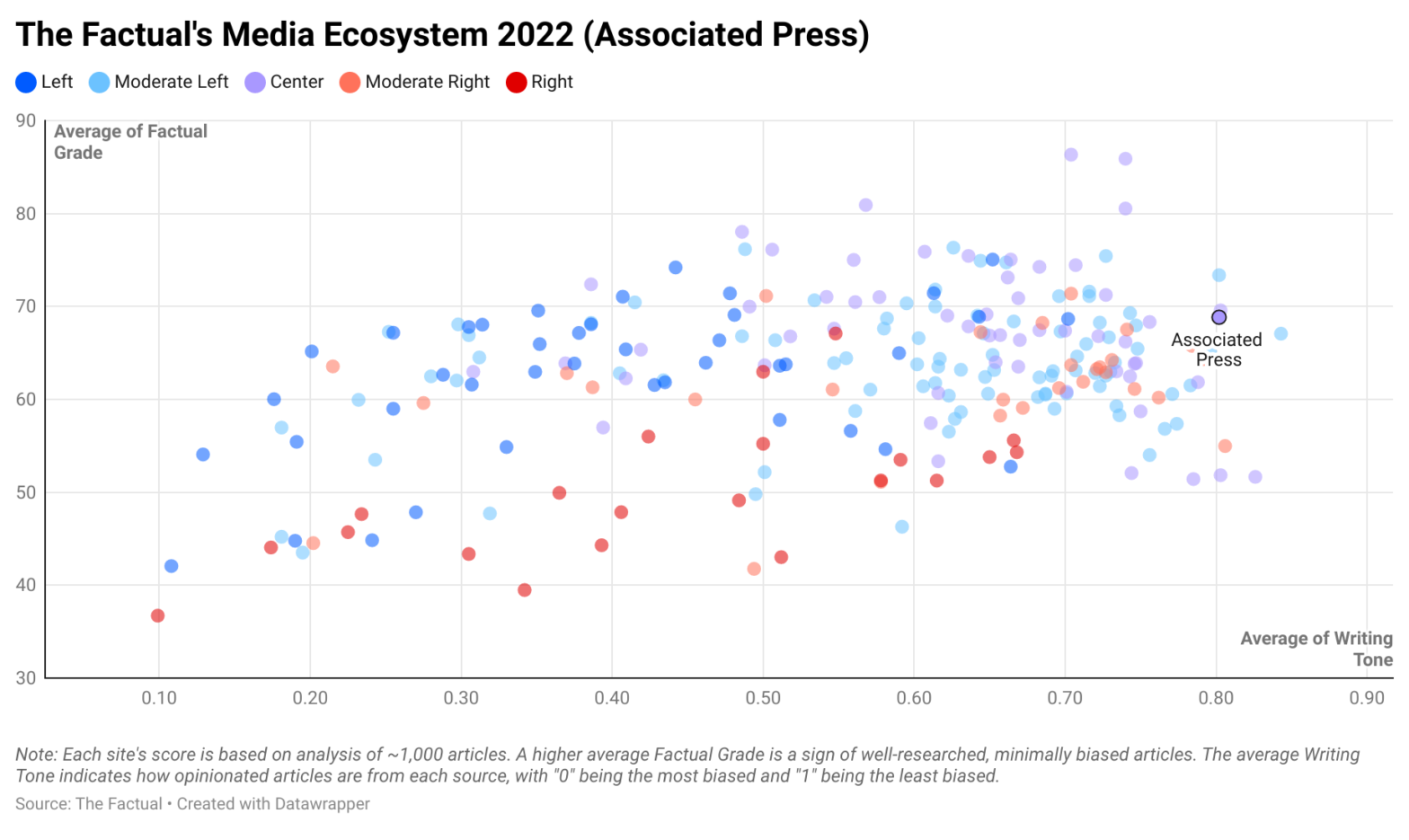The Associated Press (AP) is one of the most widely used news services in the world. As of 2016, its news reports were published in over 1,300 media outlets, including news organizations across the political spectrum and around the world. As of 2020, it had a presence in over 245 news bureaus and 97 countries, including a reporter in every U.S. statehouse. It also published over 440,000 news stories, boasting that “half the world’s population sees journalism from The Associated Press every day.” So, how reliable is AP as a news source and how biased is its news coverage?
How Does The Factual Rate News Sources?
The Factual analyzes more than 10,000 news stories every day to help readers find the most informative, least-biased articles. Our news-rating algorithm scores each article along four metrics: (1) cited sources and quotes, (2) publication history, (3) writing tone, and (4) author expertise. These scores combine in a weighted average we call a Factual Grade, which ranges from 0–100%. (See our How It Works page to learn more about our algorithm.)
For this study, we analyzed ~1,000 articles each from 240 news sources. The average Factual Grade for the entire dataset was 62.5%. Based on these averages, we can compare the performance of news sites across the media ecosystem. The entire dataset can be explored in greater detail here.
How Factual Is the Associated Press?
The Associated Press scored an average Factual Grade of 68.8%, scoring in the 79th percentile of our dataset. This score reflects the AP’s consistent, reliable reporting, which typically involves direct quotes and neutral language. Likewise, the AP employs a vast network of journalists, many of whom routinely or regularly cover the same topics for AP.
Like any news source, scores for articles from the AP varied widely based on factors like author expertise and cited evidence. For example, some scored above 80%, while others scored below 50%.
Please check your email for instructions to ensure that the newsletter arrives in your inbox tomorrow.
How Opinionated Is the Associated Press?
One of the metrics The Factual uses is the Writing Tone, which measures how opinionated the writing is in an article. For this metric, the algorithm looks for signs of subjective commentary (e.g., first person pronouns and unnecessary adverbs), as well as the emotional nature of selected words, and sees how prevalent they are for a given length of text. More neutral text receives higher ratings, with “0” being the most opinionated and “1” being the most neutral.
The AP had an average Writing Tone score of 0.80, placing it in the 97th percentile in our dataset. This is the eighth-highest score in the dataset, suggesting that articles from AP are almost always written in a highly neutral tone. This can be seen in headlines such as “Biden, Xi could meet in person, US official says” and “Trump returning to Washington to deliver policy speech.”
What Is the Political Bias of the Associated Press?
The Factual classifies news sites by political bias as either Left, Moderate Left, Center, Moderate Right, or Right. This classification is derived from third-party assessments from media bias organizations such as AllSides and Media Bias/Fact Check. Based on this data, The Factual assigns the AP a “Center” bias.
AllSides rates the AP as having a “Center” bias based on multiple editorial reviews, blind bias surveys, independent research, and 50,904 community ratings. AllSides notes that this is one of their most difficult assessments, given that their rating puts AP very close to “Lean Left.” Ultimately, they classify the AP’s global news reporting as “Center” but its Politics and Fact Check sections as “Lean Left.” In the most recent blind bias survey of over 2,000 people, “a plurality of respondents from every political group surveyed found AP News’ content to be Center, with a close second rating to be Lean Left.” AllSides does note that AP “often includes subjective, leftward analysis in hard news reports and omits sources in its political writing.” This reflects the worries of some, conservative critics about the creep of “liberal bias” at the organization, which they argue is moving away from simple reporting to providing contextual and biased analysis.
Media Bias/Fact Check (MBFC) reaches a similar conclusion, classifying AP as “Least-Biased”—MBFC’s centrist category—but close to “Left-Center.” This borderline positioning is due to left-leaning editorializing, but MBFC assesses that AP has an overall balanced story selection. AP also receives the highest possible rating for factual reporting due to proper sourcing of information and a clean fact-check record. MBFC corroborates AllSides in finding a slight left-leaning bias in some instances, though they credit AP for maintaining a largely neutral voice in coverage of the Trump presidency.
Please check your email for instructions to ensure that the newsletter arrives in your inbox tomorrow.
Who Owns the Associated Press?
The AP operates as a cooperative, unincorporated association of newspapers and broadcasters. These media outlets contribute financially to the cooperative and receive access to the AP’s news reports in return, while other groups gain access to the AP’s content through a subscription model. The AP is governed by a board of directors that features figures from big-name media organizations such as Gannet, the Hearst Corporation, the New York Times Company, and ESPN, as well as individuals from a host of smaller media groups. Given the diversity of the group’s ownership, it is difficult to conclude that the ownership structure has any direct influence on the content or bias of AP articles.
Why Does It Matter?
News articles always have some bias because all authors have some frame of reference within which they describe a story. Political bias ratings are helpful in understanding this framing. However, it can be more beneficial to know how factual an article is based on quantifiable metrics that can be seen across the media ecosystem, such as cited evidence, author expertise, and writing tone. This is what The Factual ascertains.
Reading several, highly rated articles from across the political spectrum helps counter the bias of any news source or story. To have the day’s most factual news stories delivered to your inbox every morning, subscribe to our daily newsletter.
This article was updated on September 15, 2022 to reflect new data.

